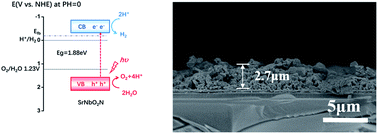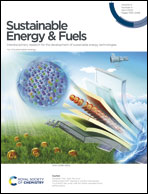Enhanced photoelectrochemical water-splitting performance of SrNbO2N photoanodes using flux-assisted synthesis method and surface defect management†
Abstract
Perovskite SrNbO2N particles were directly synthesized using a one-step thermal nitridation method with chloride flux and subsequently annealed under an inert Ar flow. By suitable adjustment of the flux synthesis parameters, including the nitridation temperature and the composition of the molten salt, preferable experimental conditions were found to suppress the formation of surface Nb defects and obtain samples with high crystallinity. The different SrNbO2N photoanodes were fabricated using the electrophoretic deposition (EPD) method followed by necking treatment. The SrNbO2N photoanode prepared using the optimum experimental conditions (nitridation temperature: 850 °C, a molar ratio of flux SrCl2 : KCl = 2 : 1) exhibited the highest photocurrent density of 2.0 mA cm−2 at 1.23 VRHE under simulated sunlight (AM 1.5G 100 mW cm−2) in a 1 M NaOH electrolyte. In comparison, the other highly defective SrNbO2N photoanodes demonstrated an unsatisfactory water oxidation performance, which demonstrates the necessity to reduce the destructive effect of defects in order to achieve a higher photocurrent density.



 Please wait while we load your content...
Please wait while we load your content...